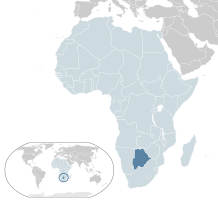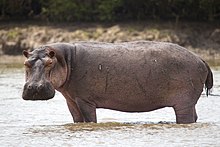Portal:Botswana
The Botswana Portal
Intro
Botswana, officially the Republic of Botswana, is a landlocked country in Southern Africa. Botswana is topographically flat, with approximately 70 percent of its territory being the Kalahari Desert. It is bordered by South Africa to the south and southeast, Namibia to the west and north, Zambia to the north and Zimbabwe to the northeast. Being a country of slightly over 2.4 million people, and roughly the size of France, Botswana is one of the most sparsely populated countries in the world. It is essentially the nation state of the Tswana people, who make up 79% of the population. The Tswana ethnic group were descended mainly from Bantu-speaking tribes who migrated southward of Africa to modern Botswana around AD 600, living in tribal enclaves as farmers and herders. In 1885, the British colonised the area and declared a protectorate under the name of Bechuanaland. As decolonisation occurred, Bechuanaland became an independent Commonwealth republic under its current name on 30 September 1966. Since then, it has been a parliamentary republic, with a consistent record of uninterrupted democratic elections, though as of 2024 the Botswana Democratic Party has been the ruling party since independence. As of 2024, Botswana is the third least corrupt country in the continent of Africa. The economy is dominated by mining and tourism. Botswana has a GDP (purchasing power parity) per capita of about $20,158 . Botswana is the world's biggest diamond producing country. Its relatively high gross national income per capita (by some estimates the fourth-largest in Africa) gives the country a relatively high standard of living and the second-highest Human Development Index of continental Sub-Saharan Africa (after South Africa). Botswana is a member of the Southern African Customs Union, the Southern African Development Community, the Commonwealth of Nations, and the United Nations. (Full article...)
Selected article -The Gods Must Be Crazy is a 1980 comedy film written, produced, edited and directed by Jamie Uys. An international co-production of South Africa and Botswana, it is the first film in The Gods Must Be Crazy series. Set in Southern Africa, the film stars Namibian San farmer Nǃxau ǂToma as Xi, a hunter-gatherer of the Kalahari Desert whose tribe discovers a glass Coca-Cola bottle dropped from an aeroplane, and believe it to be a gift from their gods. When Xi sets out to return the bottle to the gods, his journey becomes intertwined with that of a biologist (Marius Weyers), a newly hired village school teacher (Sandra Prinsloo), and a band of guerrilla terrorists. The Gods Must Be Crazy was released in South Africa on 10 September 1980 by Ster-Kinekor, and broke several box office records in the country, becoming the most financially successful South African film ever produced at the time. The film was a commercial and critical success in most other countries, but took longer to find success in the United States, where it was eventually re-released in 1984 by 20th Century Fox, with its original Afrikaans dialogue being dubbed into English. Despite its success, the film attracted criticism for its depiction of race and perceived ignorance of discrimination and apartheid in South Africa. (Full article...)Did you know -This is a good article, A-class article, featured list, or featured article, one of Wikipedia’s best work.
The hippopotamus (/ˌhɪpəˈpɒtəməs/; pl.: hippopotamuses or hippopotami), also shortened to hippo (pl.: hippos; Hippopotamus amphibius), further qualified as the common hippopotamus, Nile hippopotamus, or river hippopotamus, is a large semiaquatic mammal native to sub-Saharan Africa. It is one of only two extant species in the family Hippopotamidae, the other being the pygmy hippopotamus (Choeropsis liberiensis or Hexaprotodon liberiensis). Its name comes from the ancient Greek for "river horse" (ἱπποπόταμος). After elephants and rhinoceroses, the hippopotamus is the next largest land mammal. It is also the largest extant land artiodactyl. Despite their physical resemblance to pigs and other terrestrial even-toed ungulates, the closest living relatives of the hippopotamids are cetaceans (whales, dolphins, porpoises, etc.), from which they diverged about 55 million years ago. Hippos are recognisable for their barrel-shaped torsos, wide-opening mouths with large canine tusks, nearly hairless bodies, pillar-like legs, and large size: adults average 1,500 kg (3,300 lb) for bulls (males) and 1,300 kg (2,900 lb) for cows (females). Despite its stocky shape and short legs, it is capable of running 30 km/h (19 mph) over short distances. (Full article...)General images -The following are images from various Botswana-related articles on Wikipedia.
Related portalsOther South African countriesReligion in BotswanaCategoriesAssociated WikimediaThe following Wikimedia Foundation sister projects provide more on this subject:
|
|||||||||||||||||







































































